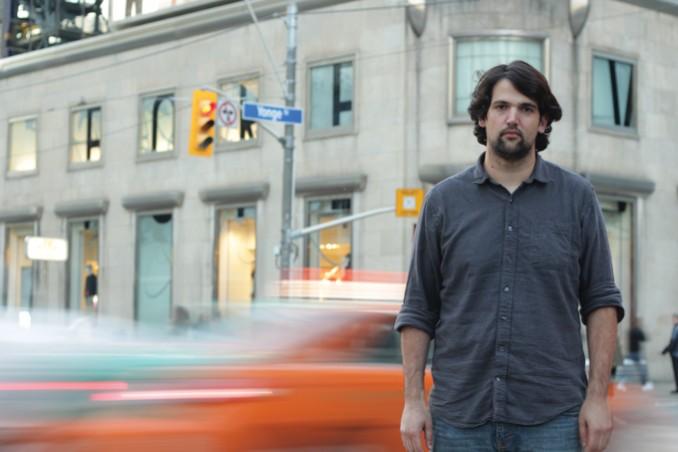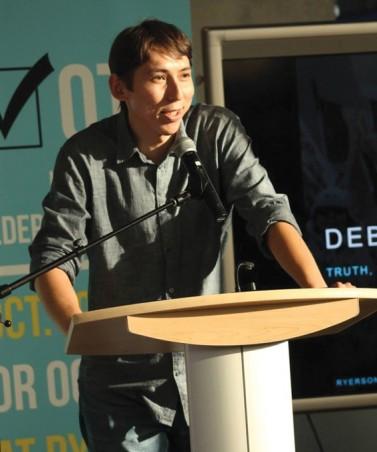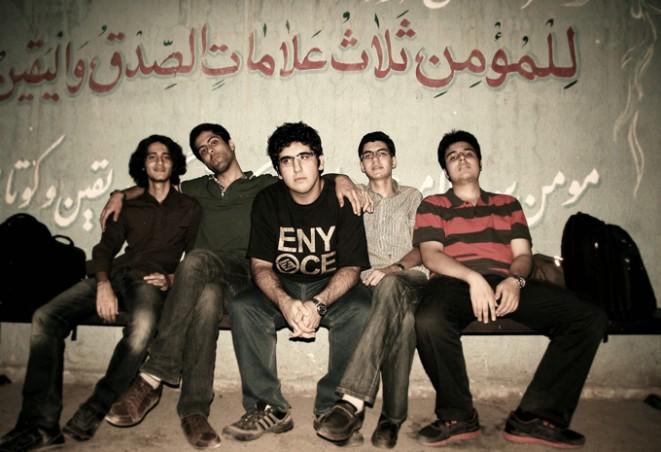By Brennan Doherty
Editor’s note: Roy Cohen approached The Eyeopener after the publication of the story to state that his reasons for moving to Canada were not a result of his mandatory service in the IDF. Rather, he came to this country to pursue opportunities not available to him in his homeland.
Roy Cohen’s Ryerson moment came fresh out of high school and a year into his three-year term of mandatory military service in the Israeli Defense Force (IDF).
He didn’t want to stay in Israel. The idea of leaving the country and attending university in North America had been lingering at the back of his mind for some time. And this moment would eventually land him in Ryerson University’s professional communications program.
“Fuck it,” he thought. He would go to North America after he finished his service term and took off the IDF uniform for the last time.
“It was always on my mind, but I never took it as an actual option,” he said. “I had some time to think about it, to prepare, to see what I could do. And, you know, funny as it is, I came here not prepared at all.”
Cohen finished his term serving with a battery of the Iron Dome, the iconic missile defence system that shielded the coastal city of Ashkelon from incoming artillery fire. Shortly after finishing his service and being discharged from the IDF, he boarded a plane for Toronto. He landed at Pearson International in November 2012 without any letters of acceptance from a university, an established place to live or even a part-time job. His parents helped a bit with his finances, but he had no established plans beyond a desire to attend university in Canada. “I thought you could just move here with a lot of money and just get by, and just do it. Well, you can if you know exactly what you’re doing. Which I didn’t,” he said.
For the next eight months, Cohen found a job and applied to universities across Toronto — dubbed the most diverse city in the world. The city doesn’t like people forgetting that claim. Ryerson is no different: seven per cent of all students who enrolled last year were born outside of Canada. Yet even in a diverse school there are outliers whose stories of arriving at Ryerson are rarely noticed. the school keeps data on international or long-distance students but it generally does not go beyond classifying them as local, out of province or international students and adjusts (i.e. vastly inflate) their tuition costs accordingly.
The Eyeopener put out the call for students hailing from remote towns, isolated villages, and far-off countries to tell us why they came here, how they adjusted and what they think of home.
These are three of their stories.
After turning left past Eriksdale, population 1,000, three hours due north from Winnipeg, the road goes on for a half-hour before the pavement ends. All the roads on the Lake Manitoba First Nations reserve are dirt roads that freeze over completely when winter hits. The reserve has a single school, a fire hall, and a convenience store. There is nowhere to buy produce or meat — that’s back in Eriksdale. This is where Kyle Edwards, a third-year journalism student, lived most of his life before high school.
The reserve has just 700 other people spread around the shores of Dog Lake. “It’s not very developed [but] it’s not poverty,” Edwards said by way of explanation. Phone signals are hard to pick up, homes are poorly insulated and many of the people who don’t own farms, teach or work at the local store are on welfare. It’s a far cry from the fully developed reserves on Manitoulin Island with their paved roads and golf courses.
Edwards’ whole world, with the exception of a few non-local teachers, was made up of indigenous people, specifically Ojibway, until Grade 3. Then the Department of Aboriginal Affairs cut Lake Manitoba’s federal funding.
“They couldn’t afford to pay their teachers anymore,” Edwards said. “We had good, educated teachers — teachers who had gone to university and graduated.” The majority were non-Indigenous professionals who got handed pink slips when funding dropped off. Good teachers willing to teach at the band’s school were few and far between — and Edwards’ mom didn’t want her sons getting a poor education. So Kyle was moved to an elementary school in Eriksdale. It may have ensured that he actually got to university at all. Not a lot of the kids he went to school with until that time ended up graduating high school.
Racism abounded in Eriksdale’s mostly white public elementary school. “They’d call me an Indian, shit like that. They’d call me a ‘fucking Indian,’ I heard that one many times,” he said. As horrible as his experiences were, a love of his culture stayed with him all the way through four years of high school in urban Winnipeg, a city that Maclean’s recently dubbed Canada’s most racist city. It stayed with him long after dropping out of his first semester at the University of Manitoba.
Ali Saremi went the opposite route. The second-year mechanical engineering student tried to distance himself as much as possible from Iran when his family left for Canada when he was 19. “Iran is not a country [where] you can be whoever you want to be and Iran’s a very nice place to live — but it has so many problems over there that makes a lot of people like me leave the country,” he said.
“All the roads in the Lake Manitoba First Nations reserve are dirt roads that freeze over completely when winter hits.”
One of those problems concerned his university days in Tehran. Saremi was enrolled for free like all Iranian youth working in fields the Iranian governments considers essential to society. Many of these fields tie into military R-and-D in one form or another. “I was involved in a project that was basically about a robotic arm mounted on helicopters so they could carry cameras,” Saremi said. His other co-op for university was far more mundane — he worked in a car factory for four months. But Saremi and his parents didn’t feel they could live within Iran anymore.
“There are basically two types of immigrants that you see here in Canada,” Saremi explained. “Some come from different countries, live here, and constantly dream of home.” He sees himself and his family in another category: those who work to call Canada home. “It doesn’t mean that they’re forgetting who they are, or that they’re forgetting their identity and trying to make a new personality. It’s about adopting and calling this place home and trying to enjoy it,” he said.
Cohen had similar thoughts after arriving in Toronto. He was born and raised in Kokhav Ya’ir (KHO-khav YA-yir) a small but wealthy settlement nestled along the Green Line, just a stone’s throw from the West Bank’s border with Palestine.
“It’s still pretty small, there is nothing to do,” he said. “There are no bars, no nothing.” Seven hundred people lived there, mostly ministers, politicians or former IDF officers like his dad. It was far from being an isolated reserve or farm town — the nearest major town, Kafer Sava (population 80,000) was just a 20-minute drive away. Many of the kids in his area still put on airs of being from the countryside and made a point of going for long hikes, exploring the abandoned wells littering the landscape and enjoying campfires under the stars.
But Cohen was far more interested in live music and photography — the only major event he’d been to in Israel was In-D-Negev, a three day indie music festival that’s held in the middle of the Negev desert every October. But North America still beckoned.
“You grow up watching all these North American movies, and then you kinda wonder how it is, what it’s like. You see these lifestyles as kind of an ideal — and I did.” he said. “It seemed appealing to me, and I love it.” Toronto has been the perfect base — and a love of music has been the perfect way to mesh with the city’s culture. “I’ve seen all my favourite bands here and that’s pretty awesome. I wouldn’t get that at home,” he said. As a freelance photographer, he’s gotten the chance to cover many of those bands too. The Globe and Mail has even picked up one of his photos.
He could have attached himself to the large Toronto-based Jewish community upon arriving here, as many from the diaspora do, but that wasn’t part of his plan.
“I’m more into assimilating and getting into the Toronto lifestyle than keeping the Jewish traditions or whatever. It’s not my thing.”
Yet doing this absolutely defined Edwards’ way into Ryerson’s doors. After dropping out of biology in his first semester at the University of Manitoba, Edwards flew out to a remote village called Merouka in Guyana to live amongst the Arawak indigenous people.
“They face the same struggles that we have here, they live on a reserve system pretty much like we do here, and they gave me permission to live in their community for five months,” he said. Originally, he just hung out in the village’s only bar and later became good friends with the village’s schoolmaster and started an after school sports and music program for students at the village’s single tiny school. “It was a really great experience, they don’t take anything for granted,” he said. The story he wrote about his experiences when he flew home to Winnipeg, published in Plan Canada, was the strongest story in his application to Ryerson’s journalism program.
When Edwards returns to Winnipeg to visit his family he always makes a point of driving up north to the Lake Manitoba First Nations. And every time he talks to his old friends, many of whom never finished high school and never went south to Winnipeg, he tells them to go back to school. “They don’t say much,” he admits.
Regardless of the distance from either Guyana, Winnipeg or Lake Manitoba First Nations reserve, he’s held true to his roots. There wasn’t a strong indigenous culture that he could find after arriving at Ryerson. “Being one of the few indigenous people in journalism, even at Ryerson, can be a little isolating,” he said. As co-founder of the Indigenous Students Association at Ryerson, he’s managed to to fill the gap — and land internships at the Winnipeg Free Press, Toronto Star and Sportsnet Magazine.
“I was involved in a project that was basically about a robotic arm mounted on helicopters so they could carry cameras.”
Saremi and his family, who recently arrived from Iran, take the opposite approach. Going back to visit isn’t in the works for a long time. And his family’s desire to blend in with Canadian life has meant a total change in pace. He and his parents don’t go out for picnics on weekends anymore — they mow the lawn, and have fun doing it.
Amonth ago Cohen and his younger brother sat in the Rogers Centre’s stands for Game 5 of the Jays-Rangers series, transfixed after Jose Bautista’s epic home run sent over 50,000 screaming Blue Jays fans to their feet in a frenzy. His 18-year-old brother wanted to see Toronto and him before starting his own deployment with the IDF.
Cohen works as one of the beer guys roaming the stadium and managed to smuggle his little brother in by slipping into the stands in uniform and letting him trail behind.
“It was one of those moments that you’re never going to forget,” Cohen said.
All three students come from vastly different cultures and hometowns. Yet thriving in Toronto required all of them to tackle their heritage. Edwards embraced his indigenous culture, Saremi dove into Canadian culture and Cohen took the middle road. Home, regardless of where it lies, was the catalyst that pushed all three to end up at Ryerson.
As for after Ryerson? Who knows where that will take them.












Leave a Reply